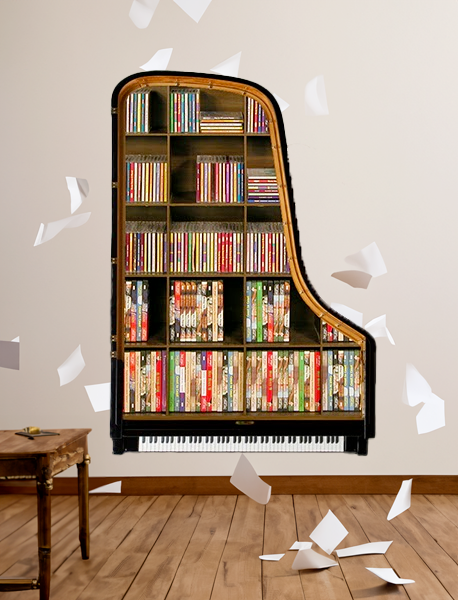
It’s a weekday evening and you have a solid number of back-to-back lessons booked as usual. You’ve got your water bottle and iPad at your side ready for the first knock on the door. The next few hours go by in a flurry of listening, feedback, and demonstration with you ending up tired but pleased knowing you used every minute of each lesson teaching effectively. What a wonderful vision this is!
Not so long ago when a student needed new repertoire, you might have opened the exam syllabus to their grade level and laboriously look for the books you knew you had on your shelf. Then came the tricky part, you had to locate the actual book, before finally checking that the piece within the book is indeed the piece listed in the syllabus (especially if the title is in another language or without reference numbers!)
Thankfully, there is another way to approach organizing your music library for teaching. A way that is more streamlined for time efficiency and remembering what you have on hand! This is the process that has made a big difference to the way I use my teaching library:
- Organise your main music library collection by instrument:
- Piano
- Voice
- Flute etc.…. whatever it is you teach.
- Organise each instrument section into categories:
Think about the categories that you most use when looking for things when you’re teaching, such as:
- Graded Repertoire
- Alphabetically by composer
- Compilations by style i.e., Popular, Jazzy, Classical
- Duets
- Sight reading, aural, theory, songwriting, and rhythm books
- Teaching books, other music texts
- Tools to assist in lesson planning to find relevant music quickly:
- Use The Hal Leonard Exam Finder. It suggests books for each syllabus and grade. https://print.halleonard.com.au/exam-finder/
- Use a digital or hard copy of a syllabus with the music or books you own/know highlighted in each grade level.
- Using the various exam syllabi lists as your guide, keep graded repertoire in the same section in your library (i.e., Piano – Grade 1 -Duets, Piano -Grade 1 – Technical, Piano – Grade 1 -Repertoire)
- On the inside cover or the contents list of your books, note the relevant grade as per the exam syllabus above. Personally, I only ever do this in grey lead pencil, however a colour-coded highlighting system per grade level is something I am considering for the future!
But what about students who aren’t doing exams?
This system works regardless of any intention to do exams. Outside of formal exams, repertoire planning and skill acquisition planning is an important part of the scaffolding we do for our students’ learning. It is helpful to both you, the teacher, and the student to have a guideline of the level of difficulty of repertoire. Exam syllabi can serve as a guide for you in that process. The board published books and manual lists have been curated for a range of styles and skills appropriate to that level. Modern, Leisure, Classical, and Jazz syllabi have a reasonably universal technical standard and that enables teachers and students to choose material at the relevant level confidently.
Accessing material quickly in lessons
Another useful system I’ve implemented is particularly helpful for online lessons. Get a set of magazine holders to put on the bookshelf beside your piano, you’ll have everything you need within arms’ reach.
- Have the books each student uses set aside and inside each book place a sticky bookmark tab on the relevant pieces for quick access.
- You could even go so far as to colour-code sticky notes. Allocating one colour to a student. Then if multiple students are using the same book, it’s much quicker to find their repertoire.
- If you want to level up even further, organise your magazine folders by grade level. In this case the student colour-coded bookmarks are so effective!
What about digital music?
To best access and organise your digital scores, using an app like forScore can be a game changer. Just like the system outlined above, you can arrange your scores by instrument, category, grade level and you can even make setlists with all the scores arranged by student.
Digital music libraries usually allow you to add an item to multiple lists, as you assign the properties to the piece itself. Then you can add your own tags, labels, and ratings! So simple once you set it up.
Lastly, a word on building your music library. I cannot overstate the benefits of building your own teaching library and helping students build their libraries too. The value of having a broad collection allows you to have ready access to material for lesson planning, gives delight in revisiting familiar music, and ensures you have new music on hand whenever the desire to extend your repertoire hits. Your music library is an asset. Consider including your library in your home contents or business insurance. Should the worst ever happen such as fire or flood, you may then be able to replace it. A teaching library is after all a tool of your trade, just like your instruments.
It may seem a little daunting to organise your music library if it is all in chaos now. But as they say, the way to eat an elephant is one bite at a time. Start with one area for your collection, create the system and stick with it. Before you know it your library with be working for you, rather than frustrating you!

‘Music has always been in Wendy’s blood and her passion grew as she discovered the benefits it gave her and others. Wendy has become known as a serial music education entrepreneur intent on making music a part of the lives of as many people as possible. Her career has taken her into schools, kindergartens, universities, retail studios and her community. Her qualifications include B.Mus.Ed, A.Mus.A, ANZCA Examiner, and Coach. Wendy studied piano with Wilma Jennings, Dr Martin Comte and May Clifford.
Currently residing in North Central Victoria, Wendy continues to mentor & teach in schools in the area, coach music teachers online, whilst managing the online version of “Wendy’s Music School” which includes her own teaching programs and coaching courses.
SOCIAL MEDIA